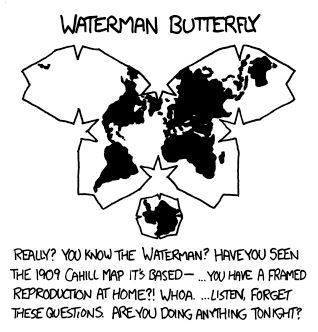I have a clear globe that i would like to project to a flat map. Any common projection should work, since computer programs exist for converting map projections. Where should i start?
A couple of details: First, my “globe” is an empty plastic Christmas tree ornament, so it can be hung from a string at one end but it doesn’t have a stand like a normal globe does.
Second, this is a worldbuilding thing. My globe does not represent any real planet or similar body, which is why i need to make a new map from the globe instead of finding an existing one.
I’m not a cartographer, but the way I’d tackle this is to drill a small hole in the globe and spray paint in through it, so that the inner surface is opaque white. Then I would put together a cheap turntable-style 3D scanner using an off-the-shelf camera (there are open source designs available for this that you can buy as a kit or print using a 3D printer, then assemble following step-by-step instructions). Then, after scanning the globe and obtaining a textured 3D model of it, it should be relatively easy to convert the globe’s texture from a spherical shape to a standard map projection using software. I don’t know what software that would be offhand, but I’m sure it exists.
Objectively, the Gott, Goldberg, and Vanderbel projection method distorts the least.
For some definition of “least”.
Using their own scoring system for distortion, a globe would be a 0, a Mercator projection would be 8.296, Winkel Tripel is a 4.563, and their projection would be a 0.881.
Well, gee, thanks for the rabbit hole!
The AuthaGraph is considered the most accurate flat map from a globe.
I guess you want a projection that distorts your oceans whilst keeping your land masses as proportional as possible, right?
Mercator always a.crowd favorite.
Any projection is a compromise. You conserve some properties at the cost of others.
You could always start with a mercator projection. They are easy enough to make (think cylinder wrapped tightly around the ‘equator’ of your globe.
Or you could go with a conic projection (think cone sitting on a gloabe like a hat) which are also simple to make. Lambert conformal conics are common in aeronautical charts.
Both of these projections are used in different maps in the real world for navigation.
Edit: Go for a browse; there are plenty of different flavors https://en.m.wikipedia.org/wiki/List_of_map_projections If your using software, then you can kinda do whatever you want without worrying about how hard or easy it is to make. 😄
Eh.

The process of actually projecting the contours on the globe onto a flat (cylindrical) map is by either putting a strong light source inside the globe and place the paper cylinder around it. This projects the contours onto the cylinder. The contours then need to be traced onto the cylinder using a pen. The other option, e.g. if the globe isn’t translucent, is to paint a longitude/latitude grid onto it and start with an empty map with the same grid. Then, for every trapezoid on the globe, its content needs to be transferred to a rectangle on the map.


